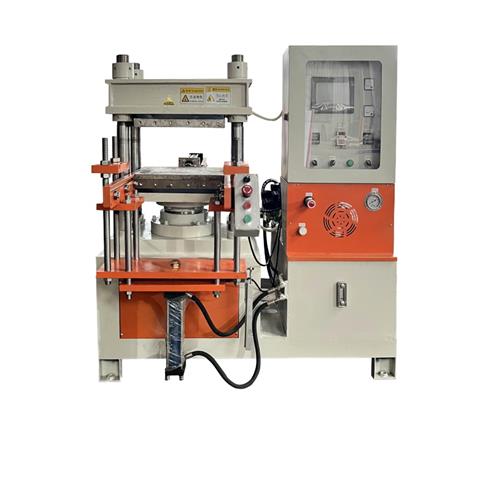
A Hydraulic Vulcanizing Machine uses hydraulic pressure and controlled heat to cure rubber, improving its strength, elasticity, and durability. It's widely used in industries for producing tires, seals, gaskets, and other rubber components. The machine ensures precise pressure and temperature control, making it essential for high-quality production and efficient manufacturing.

Features
Hydraulic drive: The hydraulic vulcanizer adopts a hydraulic drive system, which has the characteristics of smooth transmission, strong power, and easy control.
Precise temperature control: The equipment is equipped with an advanced temperature control system, which can accurately control the temperature during the vulcanization process to ensure product quality.
Stable pressure: The pressure provided by the hydraulic vulcanizer is stable and reliable, and can meet the vulcanization needs of different rubber and plastic products.
Easy operation: The equipment usually adopts PLC control, with automatic and manual operation modes, which is convenient for users to choose according to actual needs.
Compact structure: The structural design of the hydraulic vulcanizer is compact and reasonable, with a small footprint, which is convenient for users to install and use.
Advantages
Improve production efficiency: The hydraulic vulcanizer can automatically complete various operations in the vulcanization process, greatly improving production efficiency.
Ensure product quality: Through precise temperature and pressure control, the hydraulic vulcanizer can ensure that rubber and plastic products achieve ideal performance and quality during the vulcanization process.
Reduced energy consumption: The hydraulic vulcanizer adopts advanced energy-saving technology, which can effectively reduce energy consumption and reduce production costs.
Easy to maintain: The structural design of the equipment is reasonable, easy to carry out daily maintenance and maintenance, and extend the service life of the equipment.
Application fields
Hydraulic vulcanizers are widely used in the production of rubber and plastic products, such as tires, rubber tubes, rubber sheets, rubber seals, etc. Especially in the tire manufacturing industry, hydraulic vulcanizers have become one of the indispensable equipment. In addition, hydraulic vulcanizers are also suitable for other rubber and plastic products that require vulcanization, such as wire and cable sheaths, rubber soles, etc.
In order to ensure the normal operation of the hydraulic vulcanizer and extend its service life, users need to perform regular maintenance and maintenance. The following are some common maintenance methods:
Keep it clean: Regularly clean the dust and dirt on the surface of the equipment to prevent impurities from entering the equipment and affecting its performance. At the same time, keep the environment around the equipment clean and dry to prevent the equipment from being damp or corroded.
Check the hydraulic oil: Regularly check the oil level and quality of the hydraulic oil. Too low or too high an oil level will affect the normal operation of the equipment. At the same time, the hydraulic oil will gradually age and deteriorate during use, and it needs to be replaced regularly to ensure the stable performance of the equipment. When replacing the hydraulic oil, use hydraulic oil that meets the requirements of the equipment and follow the correct replacement steps.
Check the electrical system: Regularly check the connection and performance of the electrical system. Ensure that the wires are firmly connected and in good contact to avoid electrical failures that cause equipment downtime or damage. At the same time, regularly check the performance and life of electrical components, and replace aging electrical components in time to ensure the normal operation of the equipment.
Check mechanical parts: Regularly check the mechanical parts of the equipment, such as bearings, gears, seals, etc. Ensure that the degree of wear of these parts is within the allowable range, and if necessary, they should be replaced in time to avoid equipment failure or damage. At the same time, regularly lubricate mechanical parts to reduce wear and friction resistance and improve the operating efficiency and service life of the equipment.
Perform performance tests: Regularly perform performance tests on the equipment to ensure that the various performance indicators of the equipment meet the requirements of use. If the performance of the equipment is found to be degraded or a failure occurs, it should be repaired and adjusted in time to ensure the normal operation and production efficiency of the equipment.
Hydraulic vulcanizer is an important rubber and plastic product production equipment with a wide range of applications and significant advantages. In order to ensure the normal operation of the equipment and extend its service life, users need to perform regular maintenance and maintenance. Through scientific maintenance methods and management measures, the performance and production efficiency of the equipment can be effectively improved, creating greater economic benefits for the enterprise.